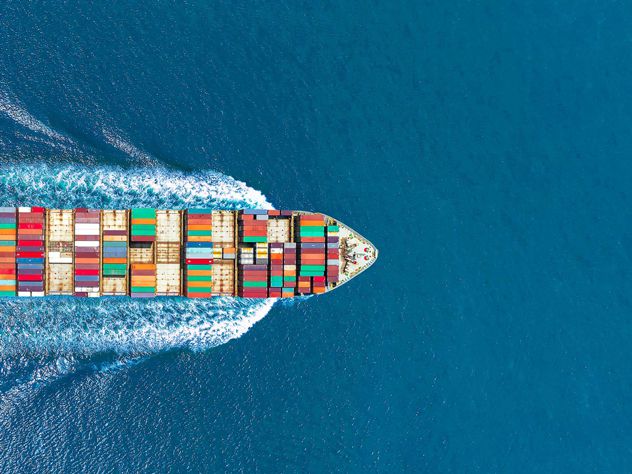As consumers become more aware of their carbon footprint, there is a growing demand for goods and services with a reduced environmental impact. Companies who minimise their carbon emissions have an advantage, creating an opportunity for differentiation based on sustainable practices. At Kuehne+Nagel, we create innovative supply chain solutions that actively reduce CO2 emissions. Through our investments in technology, we support you to achieve your bold environmental targets.
Global Sea Logistics Carbon Calculator (GSCC)
The Global Sea Logistics Carbon Calculator provides a calculation of the CO2 emission for the door-to-door transport of full containers and part loads. These calculations include current emission data by EcoTransit reported by individual carriers including pre-, main- and on-carriage. The calculation methodology and emissions factor are verified by Clean Cargo, the neutral industry body.
Please note that due to the complexity of this tool, loading might take a moment. Thank you for your patience.
For Kuehne+Nagel, visibility is just the first step. As we transition to a zero carbon business model, Kuehne+Nagel actively reduces its direct emissions. Kuehne+Nagel also develops solutions to support customers with their transition as well. We also offer carbon-neutral transport by offsetting emissions through reforestation projects. This provides an immediate step that you can take to support sustainability in logistics today. We can also provide customer-specific emission reports. Furthermore, our seaexplorer platform helps shippers to make their ocean freight more environmentally friendly. As well as providing information on the reliability and departure schedules of global ship routings, seaexplorer provides the CO2 emissions of these routings, so that you can compare them based on sustainability.
How to use the emission calculator

 How is the CO2 emission calculated?
How is the CO2 emission calculated?
Kuehne + Nagel’s emission calculator is using the methodology developed by Clean Cargo (CC) for the port to port transportation and the formula used by EcoTransit for truck or rail movements. For LCL shipments the formula uses 3 g/m3/km.

 Who is Clean Cargo (CC)?
Who is Clean Cargo (CC)?
The CC consists of the world’s largest shipping lines and works with shippers and freight forwarders in formulating universal standards for the measuring of CO2 emissions for the port to port sea transport of containers.

 Who is EcoTransit?
Who is EcoTransit?
EcoTransIT World calculates environmental impacts of different carriers accross the world, they provide an online tool for the emissions and energy consumption for all transportation modes based on an intelligent input methodology, large amounts of GIS-data and an elaborate basis of computation.

 What formula does Kuehne + Nagel use for the calculation of the port to port CO2 emission?
What formula does Kuehne + Nagel use for the calculation of the port to port CO2 emission?
Kuehne + Nagel uses the aggregated data on trade lanes reported by the members of the Clean Cargo (CC) shipping companies to CC in 2015.

 What is CO2?
What is CO2?
Carbon dioxide (CO2) is a non-flammable, colorless and odorless gas. CO2 emissions result from the combustion of heavy fuel oils as well as diesel oils when operating vessels. The amount of CO2 emissions are directly related to the amount of fuel burned. Therefore, marine fuel consumption is the basis for CO2 calculation. Carbon dioxide is the dominant greenhouse gas worldwide impacting climate change.

 Definitions of the terms used in the calculator
Definitions of the terms used in the calculator
- Carbon dioxide (CO2) - Greenhouse gas absorbing heat radiation from the Earth
- Carbon dioxide equivalent (CO2e) - Quantity of CO2 that would have the same global warming potential, when measured over a specific timescale (generally, 100 years)
- Nitrogen oxide (NOx) - Greenhouse gas and air pollutant
- Sulphur dioxide (SO2) - Potent global warming gas
- Particulate matter (PM10) - Small pieces of solid or liquid matter associated with the Earth's atmosphere
- Energy consumption (EC) - Consumption of energy of power
- Tank-to-Wheel (TTW) - Assessment related to the vehicle
- Well-to-Wheels (WTW) - Assessment related to both vehicle and energy process











